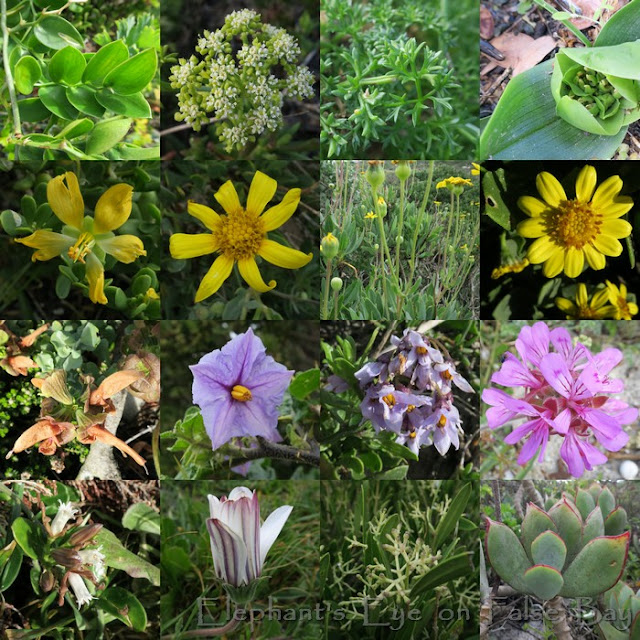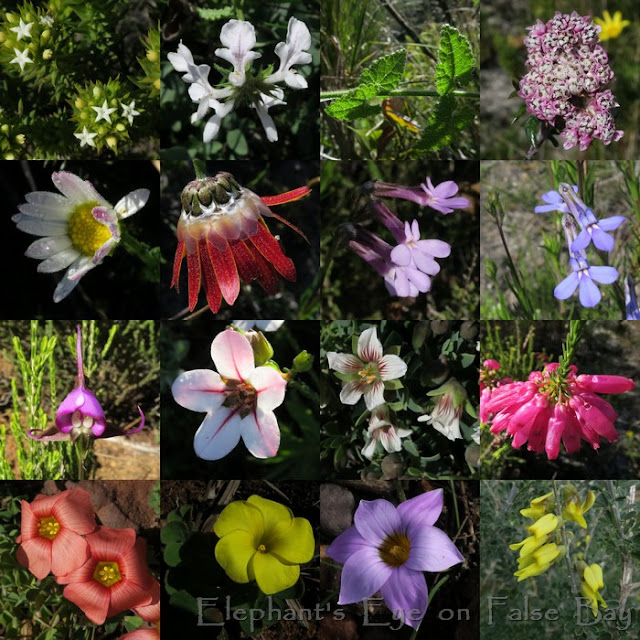Fynbos hikes among flowers and snow
by Diana
Studer
- gardening for biodiversity
in Cape Town, South Africa
Hiking among wildflowers
in the mountains
around Cape Town
Roepera flexuosa
twinleaf spekbos. Othonna coronopifolia
daisy with semi-succulent leaves. Osteospermum
incanum daisy bush.
Rusty Salvia
africana-lutea. Solanum linnaeanum
fierce prickly leaves. Solanum africanum
clusters of mauve flowers. Pink Pelargonium
capitatum.
Groundcover milkweed Cynanchum
africanum. White Dimorphotheca
fruticosa sleeping. Olea exasperata
coast olive. Pointed succulent leaves Cotyledon
orbiculata.
He hiked above Kalk Bay. We have driven past these queuing
trucks ... building site is horrifying!
We walked in Silvermine down to the Sunbird Centre. Struthiola ciliata - daphne family -
creamy yellows and all the pinks - crowned with gold.
White stars Thesium
viridifolium sandalwood family. Stachys
aethiopica purple spotted lip and leaves. Tiny pink Metalasia divergens.
Pink bud to white Polyarrhena
reflexa, or russet glory to yet a Nother yellow daisy Ursinia tenuifolia. Pink and blue Lobelia pinifolia.
Moederkappie Disperis
capensis. Adenandra villosa China
flower. White with red veins Roepera
sessilifolia. Four dents at the base of the flower Erica mammosa.
Oxalis in salmon obtusa and yellow luteola. Pink Romulea rosea.
Yellow pea standard sharply folded back Wiborgia
obcordata.
Both our groups hiked Simonsberg to see Serruria (Swartkops spiderhead protea). Black and yellow beetle on
yellow Moraea collina. Orange garnish
on yellow Sebaea exacoides gentian
family. Twirled Hermannia alnifolia. Yellow
daisy Arctotis acaulis.
Yellow daisy Ursinia
paleacea. White feathery Metalasia densa.
Hebenstreitia repens white flower
orange throat and furry beastlie. Pink Cyphia
bulbosa lobelia family.
Mauve blushed white Felicia
echinata (from the Eastern Cape). SUCH blue Roella ciliata. Pink and blue changeant Lobostemon fruticosus. Blue sage Salvia chamelaeagnea.
Absolutely tiniest red spider web flowers Cliffortia ruscifolia female. Crassula fascicularis pink and cream. Fierce
pink everlasting Phaenocoma prolifera.
After fire Protea nitida buds.
To see this Serruria hirsuta critically
endangered, rare after fire, found only on
the slope above Simon's Town.
We had invasive Himalayan
mountain tahr on Table Mountain (thanks to the former Groote Schuur zoo
they escaped from). Since they caused severe erosion they have been
methodically eliminated. Allowing us to reintroduce
the klipspringer, smaller and shyer. He saw the elusive klipspringer.
We walked from Olifantsbos to Menskop on a cold breezy day at Cape Point. Malachite
jewel beetle on Agathosma ciliaris. Nasty
weather daisy Arctotheca calendula. Yellow
pea bushes Aspalathus carnosa. Yellow
daisy with a mound of leathery leaves Othonna
bulbosa.
Pelargonium
myrrifolium. Mimetes hirtus (in peaty marshes on the road back). Cleretum bellidiforme Bok Bay vygie. Dark
Babiana ambigua.
Dipogon lignosus
edible pea (in our garden fending off snails). Flower and lichen in matching
lime orange Manulea tomentosa. Purplish
frill Muraltia spinosa tortoise
berry.
Blue and white Nemesia
affinis. Mahogany and cream Pharnaceum
lineare. Cream globes Hermannia
hyssopifolia. A Live Stream at Olifantsbos.
Typical Cape winter the two dams at Redhill was a bright
sunny day. Salt and pepper Erica
imbricata. Pink hearted Diosma
hirsuta. Sundew Drosera cistiflora.
Pink bud to cream flower Hesperantha
falcata.
Stripy daisy bud Dimorphotheca
nudicaulis. Robust sedge bergpalmiet on cool slopes Tetraria thermalis. Pincushion protea Leucospermum conocarpodendron and bee. Golden orchid Satyrium coriifolium.
Peachy Moraea flaccida.
Mimetes fimbriifolius only on the South
Peninsula. Kleinplaas Dam almost full. Sweetpea bush Podalyria sericea silvery leaves.
Selago luxurians
tiny but densely crowded. Polygala
bracteolata with white tassel. Senecio
arenarius purple daisies are everywhere. Shrubby Pelargonium cucullatum.
They hiked Perdekop above Franschhoek to reach the snow.
I invite you to join us at Elephant's Eye on False Bay.
Please subscribe as you prefer
via Feedly,
or Bloglovin,
Teal blue text is my links.
To read comments if you are in email or a Reader,
first click
thru to the blog)
Thanks for comments that add value. Maybe start a new thread
of discussion? BTW your comment won't appear until I've read it. No Google
account? Just use Anonymous, but do leave a link to your own blog. I would
return the visit, if I could...
I welcome comments on posts from the last 2 months.











Diana, I love all those gorgeous wild flowers, spring looks beautiful over there!
ReplyDeleteDelighted that the first comment is from Buenos Aires. South American blogs are the ones I work harder to find.
DeleteAstounding beauty even in winter! How I wish I could see a similar range of wild blooms within driving distance of my own home. Your Serruria is one beauty among many this month and I hope South Africa is successful in saving it, allowing it to be enjoyed by future generations.
ReplyDeleteIt is some kind of wonderful to be able to walk among an endless variety of wildflowers.
DeleteI always enjoy your spring flowers, so many of them are like ours in Australia, delicate and beautiful....even more so because they are growing wild. The houses in your photo look dangerously close to the sea!
ReplyDeleteEnjoy your spring walks.
A couple of restaurants that have big windows opening onto the sea ... suffer damage with extreme high tides.
DeleteHola Diana, he supuesto por tu comentario que tendrías algún blog y cual ha sido mi sorpresa que me encuentro con este fabuloso blog. Necesito entrar con tranquilidad sin prisas y explorar tus preciosas entradas y narraciones.
ReplyDeleteCordiales saludos y hasta pronto.
Some flower types are universal but you always blow my mind with the range in your area.
ReplyDeleteI tried, but can't comment on your blog.
DeleteI miss the crape myrtle in our Porterville garden. Cinnamon bark, but my cutting didn't survive moving.
I'll have to remember to use collages for spring wildflowers here--yours are delightful! I'd never heard of Serruria hirsuta--what a beautiful, fluffy plant, and special for its rare occurrence. Happy spring!
DeleteCollage is the only way I can squeeze in the very best of the best.
DeleteSerruria hirsuta is so beautiful! I have never seen anything like it. How come it is critically endangered? Is it difficult to propagate? Or is it on the menu of the Himalayan mountain tahr?
ReplyDeleteWe have a HUGE variety of plants in our fynbos. Many endemics. Like this one, which only grows just here. (The tahr are no longer a problem)
DeleteI was at an interesting talk last week - Kew's Millenium Seed Project. We are steadily working our way thru at least having seed available. Some plants are conserved within botanical gardens. One plant was obliterated in the wild, when a farmer illegally cleared a new field.
And I read about some of our proteas being nurtured in Welsh hills against future global warming.
As always, you see so many wonderful wildflowers on your hikes. I am fascinated by the Serruria hirsuta. I am sorry to hear it is endangered. I hope it is protected and can be saved.
ReplyDeleteThis is one of your most beautiful blog postings, Diana. P.x
ReplyDeleteHiking in the mountains through the Spring flowers, How good does it get, even a hint of snow. Glad I finally took the time to Google (Fynbos)
ReplyDeleteWow wonderful to see the abundance of so many wild flowers and the elusive klipspringer. The snow was a surprising sight too. Just hope all those trucks don't assisting in destroying this beautiful wild space. Sarah x
ReplyDeleteIt's disconcerting when a green space is revealed as 'just another plot cleared' and I realise that the urban edge, here Table Mountain National Park begins, isn't where I thought it was.
DeleteThe Serruria hirsuta is magic. So many wonderful plants. Loved seeing them.
ReplyDeleteWow! You have a wonderful assortment of lovely wildflowers! I love that Serruria hirsuta, and hope it makes a come back.
ReplyDeleteI have never seen anything even remotely resembling Serruria hirsuta. Amazing! I had to look it up to find out that it is a Protea, a genus apparently native only to South Africa and Australia.
ReplyDeleteThanks to you - I have discovered that Macadamia nuts come from an Australian protea! And Grevillea proteas in South America from Gondwanaland.
DeleteBut we have 329 species in South Africa, mostly in my South-Western Cape fynbos.
even lotus, and plane and sycamore trees are distantly related.
Delete